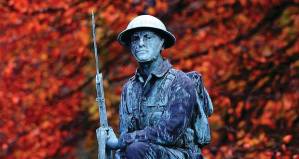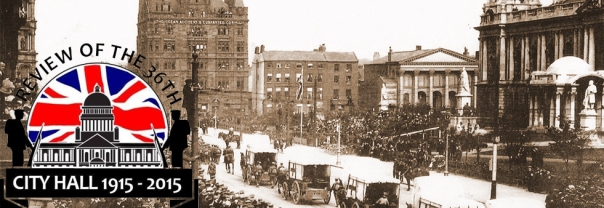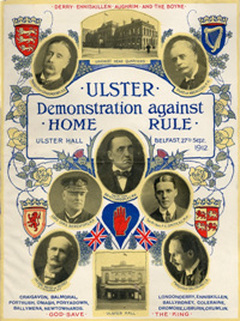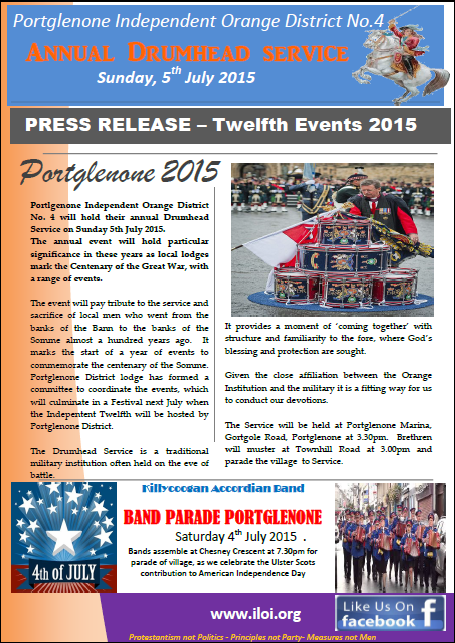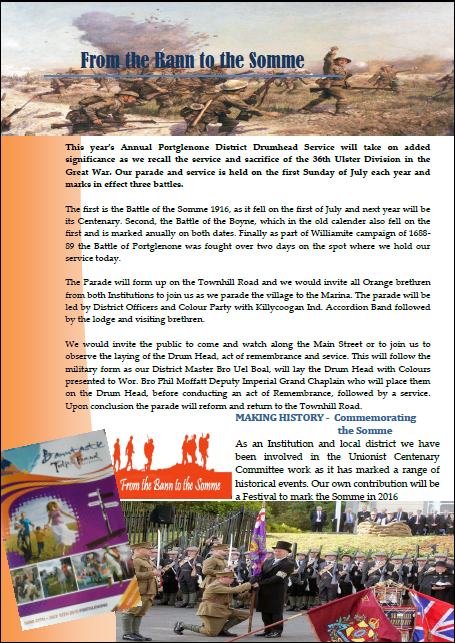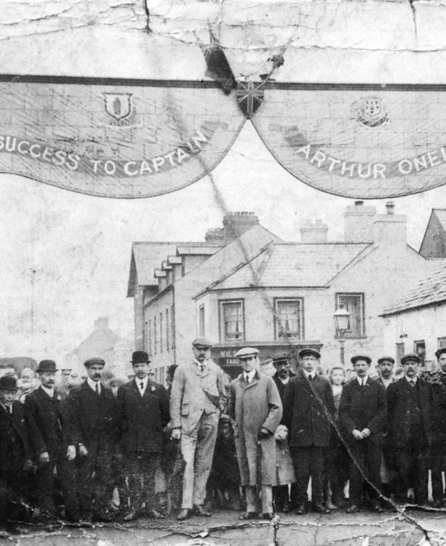Blog Archives
Portglenone Drumhead Service
Portlgenone Independent Orange District No. 4 will hold their annual Drumhead Service on Sunday 5th July 2015. The annual event will hold particular significance in these years as local lodges mark the Centenary of the Great War, with a range of events.
The event will pay tribute to the service and sacrifice of local men who went from the banks of the Bann to the banks of the Somme almost a hundred years ago. It forms the start of a year of events to mark the centenary of the Somme. The local District lodge has formed a committee to coordinate the events, which will culminate in a Festival next July when the Indepentent Twelfth will be hosted by Portglenone District.
The Drumhead Service is a traditional military institution often held on the eve of battle. It provides a moment of ‘coming together’ with structure and familiarity to the fore, where God’s blessing and protection are sought. Given the close affiliation between the Orange Institution and the military it is a fitting way for us to conduct our devotions.
The Service will be held at Partglenone Marina, Gortgole Road, Portglenone at 3.30pm. Brethren will muster at Townhill Road at 3.00pm and parade the village to Service.
This year’s Annual Portglenone District Drumhead Service will take on added significance as we recall the service and sacrifice of the 36th Ulster Division in the Great War. Our parade and service is held on the first Sunday of July each year and marks in effect three battles.
The first is the Battle of the Somme 1916, as it fell on the first of July and next year will be the Centenary. Second the Battle of the Boyne, which in the old calender also fell on the first and is marked anually on both dates. Finally as part of Williamite campaign of 1688-89 the Battle of Portglenone was fought over two days on the spot where we hold our service today.
The Parade will form up on the Townhill Road and we would inbite all Orange brethern from both Institutions to join us as we parade the village to the Marina. The parade will be led by District Officers and Colour Party with Killycoogan Ind. Accordian Band followed by the lodge and visiting brethern.
We would invite the public to come and watch along the Main Street or to join us to watch the laying of the Drum Head and our sevice, and act of remembrance. This will follow the military form as our District Master Bro Uel Boal, will lay the Drum Head with Colours presented to Wor. Bro Phil Moffatt Deputy Imperial Grand Chaplain who will place them on the Drum Head, before conducting an act of Remembrance, followed by a service. Upon conclusion the parade will reform and return to the Townhill Road.
Snapshot from History
At this time the men of the 36th Ulster Division moved to Seaford on the Sussex coast of England. Lord Kitchener inspected the Division there on 27 July 1915, and later remarked to Carson “your Division of Ulstermen is the finest I have yet seen”. Another inspection took place, by King George V, on 30 September.
3-6 October: the Division moved to France, although the artillery remained in England until November.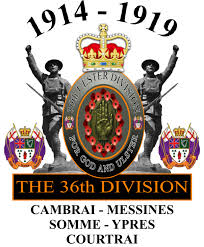
The Ulster Division initially concentrated in the area around Flesselles, some ten miles north of Arras. Gradually, men were sent in groups for familiarisation with trench warfare conditions, and were attached to the regular army 4th Division for the purpose in the (at this time) quiet are north of the River Ancre near Albert.
On 21 October the Division was moved away from the fighting area towards Abbeville, where it spent most of the winter of 1915-16 continuing training. One of the Brigades was attached to 4th Division for several weeks at this time and the artillery finally rejoined.
Come and Join us as we mark this historic event.
Local MP Commemorated
Commemoration service for first British MP to die in WW1

A local Ulster MP Cpt Arthur O’Neill was the first British MP to die in World War One. His life has been commemorated at Westminster on the 100th anniversary of his death.
The service for Capt Arthur O’Neill, who was elected as the Ulster Unionist Party MP for Mid-Antrim in 1910, was conducted by former Church of Ireland primate of All Ireland, Archbishop Robin Eames.
Capt O’Neill, father of former Northern Ireland Prime Minister Terence O’Neill, and the lodges local MP died while fighting with the 2nd Life Guards regiment at Zillebeke Ridge in Flanders on 6 November 1914, aged 38.
Arthur O’Neill, the elder son and heir of the second Baron O’Neill and Lady O’Neill of Shanes Castle, County Antrim, was educated at Eton. He was gazetted to the 2nd Life Guards from the Militia in 1897 and served in the earlier part of the South African War, taking part in the relief of Kimberley and operations in the Orange Free State at Paardeberg, the action at Dreifontein, and the action at Colesberg.


Afterwards, he served in Cape Colony, south of the Orange River, and took part in several actions, for which he was awarded the Queen’s Medal with three clasps. He was promoted to captain in 1902.
In 1902, he married Lady Annabel Hungerford Crewe-Milnes. Two of their sons were to die in action in World War Two.
Capt O’Neill represented Mid-Antrim from the general election of January, 1910 and took an active part in the formation of the Ulster Volunteer Force. Like many of the great unionist families he was anti-Home Rule and, along with Sir William Adair and the Youngs of Galgorm Castle, played a key role in the establishment of the local Ulster Volunteer Force. His military background was invaluable in establishing drilling and training regimes for recruits.
Arch in Henry Street, Harryville, erected to support Captain Arthur O’Neill in his campaign for election to Westminster in 1910. Capt O’Neill can be seen in the centre and George Young is the tall man beside him.
He rejoined his regiment only three weeks before his death. He was killed in action at Klein Zillebeke ridge in Belgium during a bayonet charge while serving with A Squadron, 2nd Life Guards and was the first sitting member of the British Houses of Parliament to be killed during the Great War.
The following is an extract from the Regimental War diary of the events of that time
” The Regt was placed in Reserve in the woods near the 4th Guards Bde H Q. At about 3.30 pm the Bde was urgently sent for and hurried towards ZILLEBEKE to support the French on the right of the Guards Bde who had been driven out of their trenches by a most determined attack.
The Regiment was dismounted under fire close to the above mentioned village and was ordered to establish iteself on the KLEIN ZILLEBEKE ridge keeping touch with the 1st Life Guards on the right who were to ? the line on the right of the Guards Brigade. Maj. the Hon. H. DAWNAY ordered the ‘B’ squadron to advance ? across the open and ? the high ground in front. ? the ‘D’ squadron was send across the ZILLEBEKE – ZWARTETEN road to ? the right flank by moving parallel to the railway. The ‘C’ troop and machine guns were kept in reserve ready to support the ‘B’ squadron. This latter squadron succeeded in reaching the edge of the wood on the ridge after ? fighting owing to the ? bring in ? of ? in?ted horses. Almost at? once the right flank of the ‘B’ became exposed to an enfilade? fire which caused Maj. DAWNAY to order the squadron to fall back slowly by troops. This order was shortly afterwards countermanded owing to French reinforcements appearing. The squadron was then ordered to fix bayonets and charge the wood which the C troop was taken by the C O to fill the gap which had occurred in between the two squadrons. This troop ? attacked the village of ZWARTETEN using the bayonet with great effect and taking a certain number of prisoners. The ‘B’ sqdn meanwhile drove back the enemy several? hundred yards and occupied a ditch 200* from their position. Owing to the trench infantry again falling back the ‘B’ sqdn and the Blues were ordered by the Brigadier to move across the ZWARTETEN – VERBRANDEN-MOLEN road and support the ‘C’ troop which was occuping a single ridge S E of the hamlet. The fighting in this vicinity became very involved owing to the somewhat precipitate retreat of the French and in consequence severe casualties were incurred. Part of the ground gained including a portion of ZWARTETEN was lost?. The situation which was becoming somewhat critical was restored by the ? of the 22nd Infantry Bde which took over the trenches held by the Bde. During these operations the ‘D’ sqdn did not fall back but retained their ground till relieved by the 60th Rifles. The confusion that occurred at one period apart from the aforementioned reason may be attributed to the very severe casualties amongst the officers / 17 in the Bde, Lord Cavan [Brigadier-General the Earl of Cavan] commanding 4th Guards Bde reported that the Bde had behaved in a most gallant manner, and that its prompt and vigorous action had saved what threatened to be a most critical situation.
MARGIN NOTES
Ref. Sheet 28
BELGIUM
*The other 3 troops of ‘C’ squadron were posted on 30th Oct at ZANBE?
Casualties
Killed
Maj. The Hon. H. DAWNAY
Maj. The Hon. A. O’NEIL[L]
2 Lieut. W. PETERSEN
Wounded
2 Lieut. T. JOBSON
Lieut. Q. SANDYS
2 Lieut. A. HOBSON
38 rank and file killed, wounded and missing
3 horses killed
The entry for this eventful day looks to have been hastily written, and is therefore difficult to read in places.

“O’NEILL, Arthur E. B., Captain, 2nd Life Guards, was KIA on the 4th [sic] November 1914. He was aged 38 and was the 2nd son of Baron O’Neill of Shane’s Castle, Randalstown.. He was the MP for Mid-Antrim and was the first MP to die in the war. He is commemorated on the Ypres Memorial (Menin Gate), Belgium.” (from Ballymena 1914-1918)
More on the officers killed on this day from Ballymena 1914-1918
His younger brother Hugh, later Baron Rathcavan, succeeded him as MP for Mid-Antrim.
 Capt O’Neill was killed three weeks after rejoining his regiment
Capt O’Neill was killed three weeks after rejoining his regimentWar Memorials Portglenone
Many local men served in both World Wars with distinction, some paying the supreme sacrifice, and it is their names we wish to remember and research in the weeks ahead as the nation pauses to remember.
Many of the memorials are in local churches, or orange halls, and the following list records the men of Portglenone and the surrounding district.
First Portglenone Presbyterian Church
| Baird | Willlam | Killycoogan | Private |
|
||
| Calwell | Joseph | Tamlaght | Private | 11th Hussars | ||
| Clarke | G. | Garvaghy | Corporal | H.L.A. | ||
| Clarke |
|
Garvaghy | Corporal | A.A.S. | ||
| Clarke | Wm. | Garvaghy | Private | Royal Scots | Killed in Action | |
| Connaughty | Hugh | Garvaghy | Private | R.I.R. | ||
| Connaughty | Robert | Garvaghy | Private | 11th R.I.R. | ||
| Coulter | Alex. | Tullnahinin | Private | I.G. | Killed in Action | |
| Dunlop | Alex. | Mullinsallagh | Private | 12th R.I.R. | ||
| Dysart | Archie | Aughnacleagh | Private | |||
| Fleming | Barkley | Garvaghy | Private | 36th R.I.R. | Wounded | |
| Haire | R. | Private | 11th Hants. | |||
| Kilpatrick | Wm. | Finkitagh | Driver | R.F.A. | Prisoner of War, Died | |
| Lamont | James | Lisrodden | Driver |
|
Wounded | |
| Lamont | Robert | Killycoogan | Driver | 16th R. Inn. Fus. | Wounded | |
| Mcilrath | Andrew | Island Cottage | Engineer | R.N. | ||
| Marshall | Samuel | Garvaghy | Private | N.I.H. | ||
| Montgomery | Thomas | Mount Horan | Private | 9th R. Inn. Fus. | Prisoner | |
| Reynolds | Wm. | Tyanee | Private | N.I.H. | ||
| Steele | David | Gortfadd | Private | 16th R.I.R. | ||
| Taylor | Robert | Private | 3rd A & S. Hlghldrs. | |||
| COLONIAL and U.S.A. FORCES | ||||||
| Andrews | John | Portglenone | Private | Can. F.A. | Wounded | |
| Clarke | James | Garvaghy | Private | U.S. Army | ||
| Clements | John | Innisrush | Corporal | T.A., U.S. Army | ||
| Kyle |
|
Tyanee House | Corporal | Wellington, N.Z., Force | ||
| Kyle | Thos. | Tyanee House | Corporal | Otago Regt., N.Z. Force | ||
| McCaughey | Charles | Ballymacpeake | Driver | U.S. Army | ||
| McCaughey | Wm. | Ballymacpeake | Corporal | Canadians | D.C.M., Wounded | |
| Montgomery | Harry | Slavanagh | Private | 20th Can. B.E.F. | ||
| Patton | Archie | Tyanee | Rifleman | N.Z. R.B. | Killed in Action | |
| Patton | James | Tyanee | Private | Aust. I.F. | Wounded | |
| Scott | James | Portglenone | Private | U.S. Army | ||
Third Portglenone Presbyterian Church
| Black | Henry | Portglenone | Private |
|
||
| Bonter | Robt. | Portglenone | Private | R.A.F. | ||
| Carleton | Robt. | Portglenone | Private |
|
||
| Holmes | Robt. | Portglenone | Private | R.D. Fus. | ||
| Law | William | Portglenone | Private |
|
Killed in Action | |
| McLean | Alex. | Portglenone | Private |
|
Killed in Action | |
| McNeill | James | Portglenone | Private |
|
Wounded | |
| Moffett | Alex. | Portglenone | Private |
|
||
| Montgomery | Robt. | Portglenone | Private | R.A.F. | ||
| Nickle | James | Portglenone | Private |
|
||
| Ross | Robt. | Portglenone | Gunner | R.F.A. | ||
| Stewart | James | Portglenone | Lieutenant |
|
||
| Stronge | Archibald | Portglenone | Private | Gordon Highlanders | Wounded | |
| Williamson | Henry | Portglenone | Private | Seaforth Highlanders | Wounded |
Duneane Congregation
| Andrews |
|
Duneane | Private | R.I.R. | ||
| Canmer | J. | Duneane | Sergeant | R.I.R. | ||
| Elliott | Rev. R. C., B.A. | The Manse | Captain | Chaplain | ||
| King | Alfie | Toome | Private | R.A.F. | ||
| McClure | Dr. S. | Artlone | Lieutenant | R.A.M.C. | ||
| Macrory | James | Duneane | Private | R.I.R. | ||
| Macrory | Robert | Duneane | Private | R.I.R. | ||
| Russell | James | Duneane | Lieutenant | R.I.R. |

